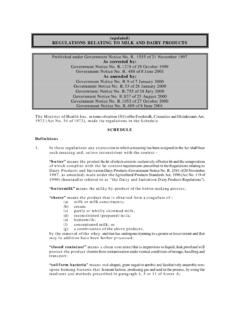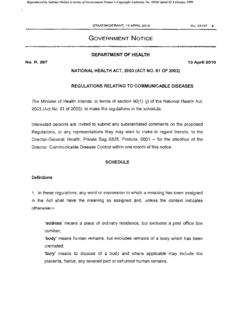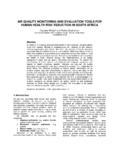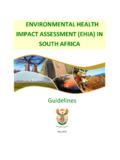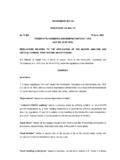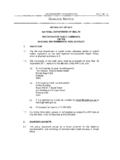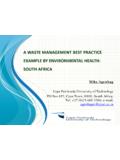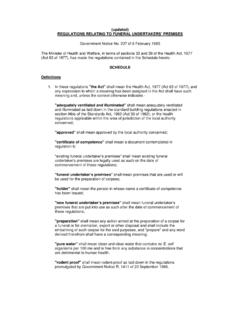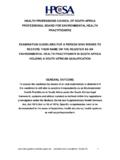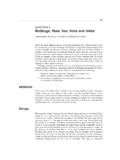Transcription of Health Professions Act: Regulations: Scope of profession ...
1 3 STAATSKOERANT, 26 JUNIE 2009 No. 32334 GOVERNMENT NOTICE GOEWERMENTSKEI\INISGEWING DEPARTMENT OF Health DEPARTEMENT VAN GESONDHEID No. R. 698 26 June 2009 Health Professions ACT, 1974 (ACT NO. 56 OF 1974) REGULATIONS DEFINING THE Scope OF THE profession OF ENVIRONMENTAL Health : AMENDMENT The Minister of Health has, under section 33(1), read with section 61 (2) of the Health Professions Act, 1974 (Act No. 56 of 1974), and on the recommendation of the Health Professions Council of South Africa, amended the regulations promulgated by Government Notice No. R. 888 of 26 April 1991, as reflected in the Schedule. SCHEDULE Definitions 1. In this Schedule, "the regulations" means the regulations relating to the Scope of the profession of environmental Health published under Government Notice No. R. 888 of 25 April 1991, and any word or expression to which a meaning has been assigned in the regulations shall bear such meaning, unless the context otherwise indicates. Amendment of the regulations 2.
2 The regulations are hereby amended by the addition at the end of the regulations as an annexure, of the following Scope of Practice of Environmental Health Practitioners: 4 GOVERNMENT GAZETTE. 26 JUNE 2009 ANNEXURE Scope OF PRACTICE OF ENVIRONMENTAL Health PRACTITIONERS In addition to the Scope of the profession as prescribed in the regulations, the following acts fall within the Scope of practice of environmental Health practitioners. Environmental Health services include performance of the following acts: (1) WATER MONITORING (a) Monitoring water quality and availability, including mapping water sources and enforcing laws and regulations related to water quality management; (b) ensuring water safety and accessibility in respect of a safe quality (microbiological, physical and chemical) and an adequate quantity for domestic use as well as in respect of the quality for recreational, industrial, food production and any other human or animal use; (c) promoting access to water for all communities by providing inputs toward the planning, design and management of the water supply system and ensuring healthy community water supplies through surveillance; (d) ensuring monitoring of effective waste water treatment and water pollution control, including the collection, treatment and safe disposal of sewage and other water borne waste, and surveillance of the quality of surface water (including sea water) and ground water.
3 (e) advocating proper and safe water usage and waste water disposal; (f) sampling and testing water in the field and examining and analysing it in a laboratory. 5 STAATSKOERANT, 26 JUNIE 2009 (2) FOOD CONTROL (a) Ensuring food safety in respect of acceptable microbiological and chemical standards, quality of all food for human consumption and optimal hygiene control throughout the food supply chain from the point of origin, all primary raw material or raw products production, up to the point of consumption; (b) inspecting food production, distribution and consumption areas; (c) monitoring informal food trading; (d) inspecting food premises and any nuisances emanating therefrom; (e) enforcing food legislation and the Codex Alimentarius; (f) applying food quality monitoring programmes and principles through various techniques, Hazard Analysis and Critical Control Points System (HACCP System) audits; (g) promoting the safe transportation, handling, storage and preparation of foodstuffs used in the Primary School Nutrition Programme (PSNP), prisons, Health establishments, at airports, etc.
4 ; (h) promoting the safe handling of meat and meat products through, amongst others, meat inspections and examination of abattoirs; (i) promoting the safe handling of milk and milk products. (3) WASTE MANAGEMENT AND GENERAL HYGIENE MONITORING (a) Ensuring proper refuse storage, collection, transportation, transfer and processing, materials recovery, and final disposal; 6 GOVERNMENT GAZETTE, 26 JUNE 2009 (b) ensuring proper management of liquid waste including sewage and industrial effluents; (c) ensuring the proper storage, treatment, collection, transportation, handling and disposal of medical waste and hazardous waste; (d) sampling and analysing any waste or waste product such as sewage or refuse; (e) investigating and inspecting any activity relating to the waste stream or any product resulting therefrom; (f) advocating proper sanitation; (g) controlling the handling and disposal of diseased animal tissue; (h) ensuring safe usage of treated sewage sludge and ensuring that reclaimed waste is safe for Health ; (iJ ensuring waste management including auditing of waste management systems and adherence to the 'cradle-to-grave' approach.)
5 (4) Health SURVEILLANCE OF PREMISES (a) Conducting environmental Health impact assessments of, amongst others, housing projects; (b) assessing aspects such as ventilation and indoor air quality, lightin~1 moisture proofing, thermal quality, structural safety and floor space; (c) assessing overcrowded, dirty or other unsatisfactory Health conditiQns on any residential, commercial, industrial or other occupied premises; (d) monitoring all buildings and all other permanent or temporary physical structures used for residential, public or institutional purposes (including Health care and 7 STAATSKOERANT, 26 JUNIE 2009 other care, detainment, work and recreation, travel, tourism, holidaying and camping) and the facilities in connection therewith and the immediate precincts; (e) ensuring urban and rural land-use planning and practices that are conducive to sustainable development by conducting sound environmental Health impact and other assessments; (f) ensuring the prevention and abatement of any condition on any premises, which is likely to constitute a Health hazard; (g) ensuring the Health safety of public transport facilities such as buses, trains, taxis, boats and aeroplanes as well as all other facilities in connection therewith; (h) ensuring compliance with the principles of Local Agenda 21 and the Healthy Cities approach to integrated service rendering and the practical minimising of any environmental Health risk.
6 (5) SURVEILLANCE AND PREVENTION OF COMMUNICABLE DISEASES, EXCLUDING IMMUNISA TIONS (a) Promoting Health and hygiene, aiming at preventing environmentally induced diseases and related communicable diseases; (b) collecting, analysing and disseminating epidemiological data and information; (c) using the Participatory Hygiene and Sanitation Transformation (PHAST) training approaches and any other educational training programmes or approaches for effectual control measures at community level; (d) conducting epidemiological surveillance of diseases; (e) establishing an effective environmental Health surveillance and information system within the different spheres of governance; 8 No. 32334 GOVERNMENT GAZETTE, 26 JUNE 2009 (f) developing environmental Health measures, including protocols, with reference to epidemics, emergencies, diseases and migrations of populations. (6) VECTOR CONTROL MONITORING (a) Identifying vectors, their habitats and breeding places; (b) conducting vector control in the interest of public Health ,including control of arthropods, molluscs, rodents and other alternative hosts of diseases; (c) removing or remedying conditions resulting in or favouring the prevalence of or increase in rodents, insects, disease carriers or pests; (d) ensuring the residual spraying of premises and precincts; (e) investigating zoonotic diseases and vector-borne diseases in the working and living environment; (f) surveying imported cargo and livestock for the prevalence of disease vectors; (g) undertaking serological testing of rodents, dogs and other pets or animals.
7 (7) ENVIRONMENTAL POLLUTION CONTROL (a) Ensuring hygienic working, living and recreational environments; (b) identifying the polluting agents and sources of water, air and soil pollution; (c) conducting environmental Health impact assessments of development projects and policies, including assessments of major hazard installations; (d) identifying environmental Health hazards and conducting risk assessment and mapping thereof; (e) preventing accidents, owing to paraffin usage; 9 STAATSKOERANT, 26 JUNIE 2009 (f) approving environmental Health impact assessment reports and commenting on environmental impact assessment applications; (g) ensuring clean and safe air externally (ambient and point sources) through emission inventory monitoring, modelling and toxicological reports, reviews and complaint investigations; (h) controlling and preventing vibration and noise pollution; (i) preventing and controlling soil pollution that is detrimental to human, animal or plant life; (j) ensuring compliance with the provisions of the Occupational Health and Safety Act, 1993 (Act No.)
8 85 of 1993), and its regulations, including anticipating, identifying, evaluating and controlling occupational hazards; (k) taking the required preventative measures to ensure that the general environme'nt is free from Health risks; (I) ensuring the registration, permitting, monitoring and auditing of all industries, activities, trade, etc., which involves controlling the internal effects of pollution on the worker and the external effects of pollution on the community and the environment; (m) monitoring management of infrastructure integrity, including management of the infrastructure integrity of pipelines and tanks; (n) ensuring, jOintly with other role players, a readiness for abnormal operating conditions and disasters; (0) developing sustainable indicators appropriate for monitoring the effectiveness of environmental management systems of industries. 10 GOVERNMENT GAZETTE, 26 JUNE 2009 (8) DISPOSAL OF THE DEAD (a) Controlling, restricting or prohibiting the business of an undertaker or embalmer, mortuaries and other places or facilities for the storage of dead bodies; (b) monitoring practices at cemeteries, crematoria and other facilities used for the disposal of dead bodies; (c) managing, controlling and monitoring exhumations and reburials or the disposal of.
9 Human remains. (9) CHEMICAL SAFETY (a) Monitoring and regulating all operators, fumigation firms and formal and informal retailers that deal with the manufacture, application, transport and storage of chemicals; (b) permitting, licensing and auditing the premises of the above, by issuing Scheduled Trade Permits; (c) faCilitating advice, education and training on pesticides and/or chemical safety. (10) NOISE CONTROL (a) Assessing the extent of noise pollution and its effects on human Health ; (b) facilitating noise control measures; (c) measuring ambient sound levels and noise levels. (11) RADIATION (IONISING AND NON-IONISING) MONITORING AND CONTROL (a) Ensuring ionising and non-ionising radiation sources are registered with the Department of Health ; STAATSKOERANT, 26 JUNIE 2009 11 (b) ensuring registered ionising and non-ionising sources meet licence conditions; (c) monitoring the safe transportation of radioactive material to ensure compliance; (d) ensuring radioactive sources are licenced at the South African Nuclear Energy Corporation (NECSA); (e) ensuring the proper disposal of all radiation waste materials from hospitals and other licensed establishments; (f) ensuring protection against any form or sources of electromagnetic radiation.
10 (12) PORT Health (a) Monitoring, inspecting, sampling and labelling all imported foodstuffs, cosmetics and disinfectants at all ports of entry (harbours and border posts); (b) monitoring all imported foodstuffs, cosmetics and disinfectants for which a certificate of approval is required; (c) sampling foodstuffs consumed on board all aeroplanes and ships; (d) monitoring, inspecting and sampling (for chemical and bacteria testing purposes) all maize and wheat imports; (e) monitoring continuous rodent and vector control at airports and harbours; (f) monitoring imports of used pneumatic tyres for the prevalence of mosquitoes such as the Aedes species (vectors for yellow fever, dengue fever and encephalitis); (g) providing a continuous vaccination programme for seafarers at all ports; (h) monitoring and inspecting all hazardous cargo entering the country; (i) monitoring and preventing communicable diseases on a 24 hour-basis; 12 GOVERNMENT GAZETTE, 26 JUNE 2009 (j) monitoring water on board ships to ensure that it is safe for human consumption; (k) monitoring food wastes and medical waste for disposal.
